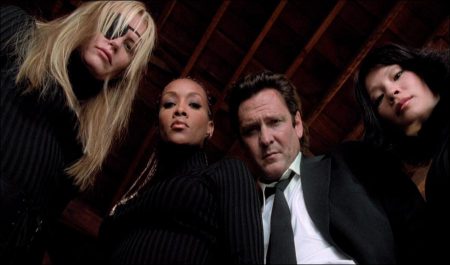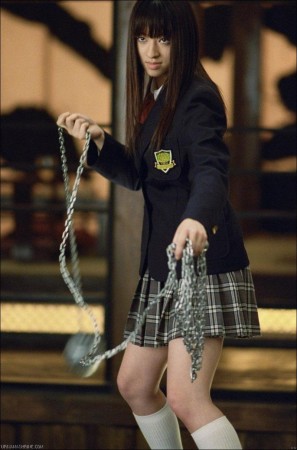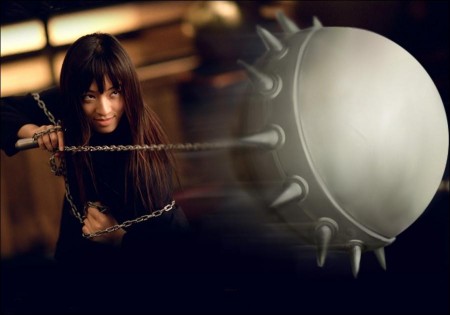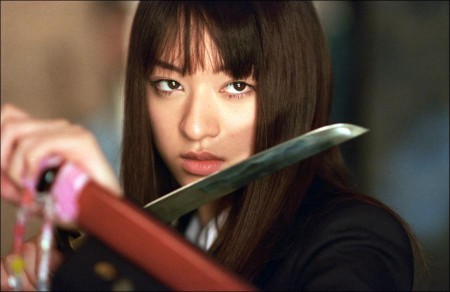In Okinawa, The Bride acquires a legendary bladed weapon from the last of the world’s great samurai sword-smiths, the legendary ninjitsu master Hattori Honzo (Sonny Chiba). In Tokyo, O-Ren Ishii is surrounded by her lethal henchmen and holds court in a massive nightclub / restaurant complex, the House of Blue Leaves. The Bride’s assault upon this stronghold is a pitched martial arts battle with hundreds of black clad soldiers of O-Ren’s personal shock squad, The Crazy 88s.
The assault also includes personal showdowns with two of O-Ren’s top aides, her personal assistant, Sophie Fatale (Julie Dreyfuss), and her private bodyguard Go Go Yubari (Chiaki Kuriyama). The assault culminates in a classic, tragic snowy standoff between these two formidable warriors, O-Ren Ishii and The Bride. We begin to sense that the quest for justice could exact a heavy emotional toll upon The Bride.
A few days later, in Pasadena, California, The Bride has moved on to her second knockdown- drag-out battle with a Viper target, Copperhead, a.k.a. Vernita Green (Vivica A. Fox). The presence of Vernita’s young daughter at the scene adds a note of grim irony to the tale of a widowed mother’s quest for retribution. In the aftermath of the epic Tokyo battle, Bill appears on screen for the first time to question the fight’s sole survivor, Sophie Fatale, about The Bride’s intentions. “Does she know,” Bill asks Sophie, “that her daughter is still alive?”
In Kill Bill— Vol. 2 the emotional momentum that builds throughout Vol. 1 will achieve its cathartic resolution, as The Bride goes through the remaining Vipers (including Michael Madsen’s Sidewinder) to reach the man himself, the father of her child, and make a deeply poignant discovery.
Introduction
KILL BILL is both an homage and a reimagining of the genre films that Quentin Tarantino has seen and loved: spaghetti westerns, Chinese martial arts films, Japanese samurai movies as well as anime. Put simply, Tarantino describes the movie as a “duck press” of all the grindhouse cinema he’s absorbed over the past 35 years. The film is conceived in chapters, each with the characteristic look and pulse of a specific genre and then interwoven with references from pop culture and other genres.
When a rubout sequence from a yakuza film is presented in Japanese anime imagery with a score lifted from an Italian Western what comes through is a sense of the thematic and emotional binding energy that gives all of these forms their enduring power. Tarantino evokes not just the gaudy, engaging surface of genre cinema but also its rebel spirit.
As a result the archetypal characters of Vol 1. have a surprising undercurrent of emotional conviction that pulls us toward the ultimate confrontations of Vol. 2. .Kill Bill-Vol. 1 opens nationwide on October 10, 2003, with Kill Bill Vol. 2 following on February 20, 2004.
South Bay Days
Strange as it may sound, some of the origin of Kill Bill is geographical. Tarantino spent his youth in the South Bay, the region south of Los Angeles in Orange County that includes Manhattan Beach. His previous movie, Jackie Brown (1997) is set in that vicinity and is a showcase for the area’s many charms.
The South Bay was an area that still had second-run “grind houses,” showing blaxploitation and kung fu films, long after the market had dried up in more northerly sections of the city. “I was a little kid when the kung fu explosion hit in the early ’70’s,” Tarantino recalls, of his schooling in Old School Martial Arts Cinema. “For about two years they were showing all these kung fu films all the time. And even after the kung fu craze died out everywhere else, it was kept alive in the late 70’s and early 80’s in areas like the South Bay, in grind houses and ghetto theaters. I think it’s one of the greatest genres of cinema that ever existed.”
On television, Tarantino watched The Green Hornet, which featured a young Bruce Lee as the title hero’s masked sidekick, and later followed the exploits of David Carradine’s Eurasian kung fu master, Caine, on the ABC-TV series Kung Fu. A few years later he extended his interest in Asian action genres, tuning in a local Japanese-language UHF station to follow the subtitled exploits of Sonny Chiba’s ninja-detective, Hattori Hanzo, on the imported series Shadow Warriors. When the new wave of Hong Kong action cinema hit in the mid-1980s, Tarantino, by then a video store clerk in Manhattan Beach, was one of its earliest and most vociferous boosters.
Knowledgeable Tarantino-philes have been spotting the influence of these punchy films on the writer/director’s work right from the beginning: Sonny Chiba’s ultra-violent Streetfighter films influenced the screenplay for True Romance and the Hong Kong action movie City of Fire was given a nod in his thunderous directorial debut, Reservoir Dogs (1992). “Sonny Chiba was to me right up there in the 1970s with Charles Bronson and Clint Eastwood as one of the greatest action stars,” Tarantino says.
“I’m a huge fan of the period martial pictures made in the ‘70s by the Shaw Brothers in Hong Kong,” he says. “If my life had two sides, one side would be Shaw Brothers and the other side would be Italian westerns. Actually they all have influences on each other. There are many things in Shaw Brothers movies which were borrowed from Italian westerns. During the 1970’s, movies from these two genres often used similar plots, images and shots. There’s a fairly deep kinship.”
Asian Influence
The influence of Asian cinema on Kill Bill extends well beyond it storylines and visual style:Tarantino also created roles in the film for three of the martial arts genre’s legendary actors. For Japanese cinema’s renowned sword master Sonny Chiba, he revived the Ninja character Hattori Hanzo, from the series Shadow Warriors.
Tarantino cast Chinese martial artist/actor Gordon Liu Chia-hui as both Johnny Mo, his Reservoir Dogs black suit-clad leader of the Crazy 88 bodyguard squad in Tokyo, and as Pei Mei, a popular “white eyebrowed monk” character from several vintage Shaw Brothers films (featured in Kill Bill – Vol. 2). In this case he was casting against type: Liu always played stalwart (or occasionally comic) heroes in his Shaw films, while Pei Mei (often portrayed by actor Lo Lieh) was one of the studio’s darkest villains, betraying his martial brothers to the Manchu tyrants in pictures like Liu Jia-liang’s Executioners From Shaolin (1977).
Liu was impressed when he learned that David Carradine had been cast in the movie’s title role. During filming in China, he made a point of taking the actor aside to tell him how much he had admired the program. “That series was a very important part of people in the West understanding kung fu,” Liu explains.
Another World
It is important to point out that Tarantino has not merely duplicated his genre sources in Kill Bill. He has transformed them; filtered them through the sensibility of a devoted American fan whose imagination functions as a melting pot (or as he would say, a duck press) that reveals the kinships between seemingly unrelated genres.
“I have said many times,” he explains, “that there are two different worlds that my movies take place in. One of them is the ‘Quentin Universe’ of Pulp Fiction and Jackie Brown — it’s heightened but more or less realistic. The other is the Movie World. When characters in the Quentin Universe go to the movies, the stuff they see takes place in the Movie World. They act as a window into that world. Kill Bill is the first film I’ve made that takes place in the Movie World. This is me imagining what would happen if that world really existed, and I could take a film crew in there and make a Quentin Tarantino movie about those characters.
“This movie does not take place in the universe that we live in. In this world women are not the weaker sex. They have exactly the same predatory hunting instincts as the men, the same drive to kill or be killed.” The challenge of living inside Tarantino’s alternate B-movie universe, Uma Thurman says, “is walking an incredible line of finding the humanity inside this unreal, insane, mad, epic.”
Two Volumes
Originally planned as a single film, the movie will be presented in two installments, Kill Bill-Vol. 1 and Kill Bill-Vol. 2. “If I had thought while I was writing it,” Tarantino says, “that [Miramax co-chairman] Harvey Weinstein would be willing to release it in two parts, I would have suggested it then. But I frankly never thought he would. Later on, when he himself said he didn’t want to cut a thing and would we consider releasing it as two movies, I said, ‘What an interesting idea!’ Within an hour, I had figured out exactly how to do it.”
When the time to make the final decision rolled around, in the summer of 2003, Tarantino showed Weinstein his cut of what would soon be designated Kill Bill-Vol. 1. He introduced the screening by saying: “This is either the first movie, or it’s the first half of the movie”. Weinstein’s response was unequivocal: “This is a terrific ending! So that’s it! It’s two movies!”
There is certainly more precedent in American film distribution now than ever before for planning films from the outset in terms of a series of several installments. And in Europe and Asia this has been common practice for decades. In fact, one of the key influences upon Kill Bill, Kinji Fukasaku’s Battles Without Honor and Humanity, was an epic gangster drama about the decline of a yakuza clan, which was released in several installments from 1973 to 1976.
Two Volumes, Two Masters
As it happens, each of the two volumes of Kill Bill has its own tone and mood and employs quite different narrative strategies. In terms of its Asian influences, for example, Vol.1 is dominated by Japan, as personified by Sonny Chiba (The Streetfighter), who plays the samurai sword maker Hattori Hanzo and who served as the film’s kenjutsu choreographer.
Vol. 2, on the other hand, is dominated by China, as personified by martial arts movie legend Gordon Liu Chia-hui (The Master Killer), who plays the Bride’s implacable Shaolin Five Animals kung fu instructor, the “white eyebrow” monk Pei Mei. (Liu also has a small role in Vol. 1 as yakuza boss O-Ren Ishii’s top enforcer, Johnny Mo).
The numerous Spaghetti Western references in Vol. 1, particularly in the haunting strains of some of Tarantino’s musical choices, will pay off powerfully in Vol. 2, when The Bride encounters Michael Madsen’s Budd (aka Sidewinder) in El Paso, Texas, and tracks Bill to Mexico.
And then there is the odd fact that the title character, David Carradine’s Bill, barely appears at all in Vol. 1. His spirit certainly looms large, and his inimitable murmuring voice can be heard the soundtrack on several occasions.“ He is all over Vol. 2,” Tarantino says, “which is really all about the confrontation between the two of them.
There was also a much simpler practical consideration, Tarantino says, for dolling out Kill Bill in smaller, measured doses: After all, the final fight sequence in Vol 1., “The Showdown at the House of Blue Leaves,” is a 20-minute samurai sword battle between The Bride and the minions of killer-turned-yakuza boss O-Ren Ishii (Liu), that took a full eight weeks to shoot, on a soundstage at the Beijing Film Studio— only two weeks less than the entire production schedule of Pulp Fiction. “When you get to the end of Vol. 1,” Tarantino says, “you’re exhausted. You’re ready to take a break.”
On a more philosophical level, Tarantino suggests, “This is supposed to be my version of a grindhouse movie, and the very idea of a three hour grindhouse movie is a contradiction in terms. It seemed pretentious, whereas two 90-minute grind house movies seems more app.”
Served Cold
Kill Bill has the basic plot structure of a kung fu film, a format that has been central to the genre right from the beginning, from seminal early Shaw Brothers films such as Chang Cheh’s One-Armed Swordsman (1967) to American derivatives like The Karate Kid (1984). One thing that is clearly not missing, however, is the traditional samurai swordsman or kung fu hero’s do-gooding code of honor.
Says Uma Thurman “For me the important thing is that the character has a certain nobility. She’s not just sneaking up on people and trying to knock them off. She goes to each of the other Vipers, meets them on their own turf, gives them the choice of weapons, and basically challenges them to a duel. So there is a code of ethics that she follows— the Viper Rules of Honor that Quentin laid out for me.”
“Once I got going, I just wrote and re-wrote for a whole year,” Tarantino says. “If I hit a snag I would just stop and go watch a martial arts movie. I basically watched at least one Hong Kong movie a day, and sometimes two or three a day. I also watched Japanese samurai movies and anime. So images from these movies just filled my head until they were second nature, and that became the raw material of Kill Bill. I knew absolutely nothing about any of the Hollywood movies that had been released during that year.”
Tarantino consulted often with his designated leading lady during the writing process: “I even left the character as written somewhat more open than I usually do, so that she could continue to contribute.”
He also began the process that Thurman calls “his genre film schooling of me. Way back when the idea was first created he screened John Woo’s The Killer, and the Pam Grier film Coffy, the Sergio Leone/Clint Eastwood films, John Flynn’s Rolling Thunder, and Lady Snowblood, a Japanese female-samurai film was a big inspiration. Just piles and piles of stuff, these action movies that were all sort of terrifying to me. It was like, ‘What is he writing for me?’”
Kill Bill Vol. 1
Directed by: Quentin Tarantino
Starring: Uma Thurman, David Carradine, Daryl Hannah, Michael Madsen, Sonny Chiba, Julie Dreyfus, Chiaki Kuriyama
Screenplay by: Quentin Tarantino
Production Design by: Yohei Taneda, David Wasco
Cinematography by: Robert Richardson
Film Editing by: Sally Menke
Costume Design by: Alexander AD, Kumiko Ogawa, Catherine Marie Thomas
Set Decoration by: Yoshihito Akatsuka, Sandy Reynolds-Wasco
Music by: RZA
MPAA Rating: R for strong bloody violence, language, sexual content.
Studio: Miramax Films
Release Date: October 10, 2003






